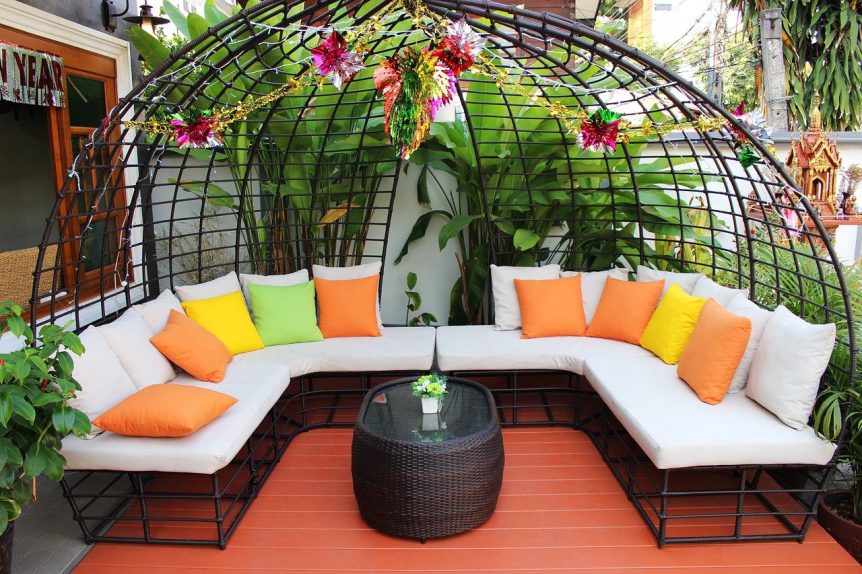If you choose it wisely and source it from a reputable supplier, your patio furniture can last a really long time and make for the centrepiece of your outdoor experiences to come. As robust as its indicatively built though, patio furniture still needs a little bit more extra-special care than you’d give your regular, indoor furniture.
It typically gets more exposure to the elements, so naturally, it’d never be a matter of just placing it and dusting it off once in a while. So, how can you preserve the beauty and functionality of your outside furniture? Let’s look at the tips below.
Consider the material
As mentioned above, patio furniture has to weather the elements – dust, rain, heat, etc. – which means that it should be made of strong and durable material. While there are a number of different choices out there, using reclaimed wood is a popular choice these days.
Firstly, it is a sustainable and eco-friendly option. Secondly, it has already stood the test of time and is therefore tougher than virgin wood. Thirdly, it is widely available these days, as you could purchase it online (you could buy here, for one) and have it delivered to your home. After that, it is only a matter of hiring a carpenter and putting it together in the way you like. If you are struggling to come up with ideas, there are ways to find inspiration.
Take inspiration from commercial dining establishments
Part of what makes the experience of visiting your favourite restaurant professional is its choice of pieces such as the outdoor furniture they have available for outdoor dining. You don’t notice until you’re compelled to take a closer look, but otherwise looking towards these commercial dining establishments for inspiration goes beyond just the styling.
Your subsequent decision to go with an extending, deluxe teak outdoor table and chair set, would have taken into account the durability of the set if you drew inspiration from a commercial dining establishment. You would have accounted for the quality element by default, alongside the styling.
Take heed of the specific product care guidelines
Now, getting into the actual care of the pieces; even the most high-quality and durable of patio furniture needs to be cared for. There are some general guidelines to follow, such as how you would do well to place it under cover, apply some protective coating and clean regularly. However, each patio furniture piece ideally comes with a set of product care guidelines that are more specific to that piece, so never discard these guidelines.
They are indeed merely guidelines, so taking heed of them doesn’t mean you don’t have to apply any extra care.
Under cover
Outdoor garden and patio furniture will inevitably be exposed to the elements, but if you can minimize any exposure, then that’s exactly what you should aim for. However, this can be much easier said than done. For example, did you know that something as seemingly insignificant as limiting direct exposure to the sun’s UV rays can extend the lifespan of your furniture?
And it’s not just the sun that you need to think about. You must also think about other treacherous weather conditions that your furniture could be subjected to, such as snow, rain, and frost. But worry not. The best way to keep your pieces protected is to keep them undercover, like using an outdoor furniture cushion cover replacement for your seating, or moving them under a protected space when not in use. This can help to preserve it for many more years to come.
Proactive protection
Within the guidelines of the manufacturer, of course, specific patio furniture pieces, such as wooden furniture, should be sealed with a protective coating, like paint or varnish. This can also give it an enhanced appearance, but ultimately it’s about protecting the surface. Ensure to apply enough sealant to hard-to-reach areas and try to get the job done “evenly” so that everything dries up at around the same time.
Cleaning
The basics of cleaning patio furniture revolve around keeping it dust and moist-free, cleaning off the surface as quickly as you can after each use, to avoid liquid and other substance stains that might get harder to clean the longer they’re left on. A good old soapy solution will usually do, with a thorough clean every so often required as well.
- Best learning toys for children as they age - July 19, 2023
- Luxury yacht charter vs. standard yacht charter: Which is right for you? - February 7, 2023
- Comfortable Shoes for Being on Your Feet All Day - January 10, 2023

Like It? Share It!